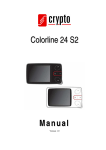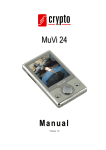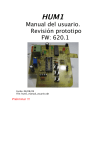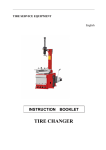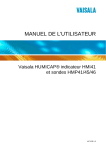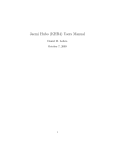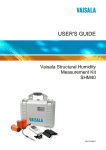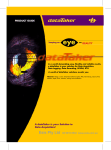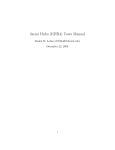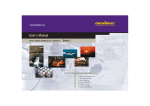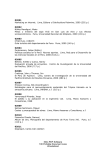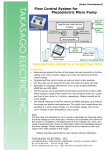Download Use of salt solutions for assuring constant relative humidity
Transcript
PROJETOS DE INVESTIGAÇÃO CIENTÍFICA E DESENVOLVIMENTO TECNOLÓGICO RELATÓRIO REFERENTE AO PROJETO PTDC/ECM/099250/2008 “Comportamento em serviço de estruturas de betão: uma abordagem multi-física das tensões auto-induzidas” Use of salt solutions for assuring constant relative humidity conditions in contained environments Autores: Gonzalo Quincot Miguel Azenha Joaquim Barros Rui Faria Guimarães, UM, 2011 União Europeia – Fundos Estruturais Governo da República Portuguesa Content 1. Introduction ................................................................................................................................ 3 2. Salt solutions for humidity calibrators ........................................................................................ 4 3. Equipment to measure temperature and relative humidity ....................................................... 5 2. 3.1. Measuring systems .............................................................................................................. 5 1.2. Preliminary sensor testing ................................................................................................. 12 Experimental program .............................................................................................................. 13 2.1. 2.1.1. Containers ................................................................................................................. 13 2.1.2. Testing the salts......................................................................................................... 13 2.1.3. Preparing the salt solutions....................................................................................... 15 2.2. 5. Environmental moisture control in containers ................................................................. 13 General outline: basic principle and procedure ................................................................ 17 2.2.1. Test with different salts............................................................................................. 17 4.1.2. Test with the same salt (NaCl)................................................................................... 20 Results and discussion ............................................................................................................... 21 5.1. Measurements for the containers with different salts ..................................................... 21 5.2. Measurements for the containers with the same NaCl salt ............................................. 25 5.3. Water loss from the glasses placed inside the containers ................................................ 30 6. Conclusions ............................................................................................................................... 31 7. References ................................................................................................................................. 32 European Union Governo da República Portuguesa 1. Introduction To obtain a relationship between moisture loss and shrinkage in concrete structures it is necessary to determine the moisture profile in concrete along time. Regarding internal moisture content in concrete, there are several measurement methods, mostly based on the measurement of internal water concentration and on relative humidity. According to the objectives of the project, both kinds of methods will be used. Many samples and tests have to be done before obtaining reliable results. One of the main issues that influence moisture profiles in concrete samples is related to the environmental conditions to which the specimens are subjected (e.g. humidity, temperature, wind speed). For a proper characterization of the influence of environmental conditions on moisture losses, such conditions have to be known and stable. The experiments initially envisaged in the scope of this project aim to have constant temperature, relative humidity and wind speed throughout the whole testing period. The experiments described in this report have the intention of creating known environmental conditions in containers where the samples and specimens are to be tested. Such conditions are relatively easy to achieve through the use of climatic chambers. However, the number of climatic chambers is usually limited in laboratories, and the climatic conditions are not always suitable for the experiments conducted by the several researchers of the laboratory. With this limitation in view, it was decided to test the possibility of assuring constant humidity conditions inside plastic containers through the use of salt solutions usually applied in calibration of humidity sensors. The intention is to have several testing humidities inside a climatic chamber that just needs to control temperature (much cheaper than humidity control). In the scope of this report, a walk-in climatic chamber with 20°C ± 0.2°C and RH = 60% ± 3% is used. To achieve the necessary conditions, salt solutions with a known target relative humidity (according to their use in humidity sensor calibration in Vaisala´s user manual) were placed in closed containers (where specimens will expectably be placed for testing).The humidity inside the containers was continuously monitored through the use of several types of humidity sensors, thus European Union Governo da República Portuguesa allowing to relate the salt solution efficiency in view of the targeted relative humidity in the container, and its stability along time. Conclusions are withdrawn in regard to the behaviour of the tested types of humidity sensors. 2. Salt solutions for humidity calibrators Vaisala is a company that sells relative humidity sensors, among other measurement equipment. In the scope of this project, the Vaisala humidity calibrator HMK15 (see Fig. 1) was purchased, together with the Vaisala HM44 set for measuring humidity in concrete. Fig. 1. Vaisala HMK 15 relative humidity calibrator The HMK15 calibrator is based on known relative humidity being assured by salt solutions for a specific chamber volume of 20 cm3 (diameter = 5 cm, height = 3.5 cm). The salts used in the calibrator are Lithium chloride (LiCl), Magnesium chloride (MgCl2), Sodium chloride (NaCl) and Potassium sulphate (K2SO4). The salt solution and the expected relative humidity values in the chamber are shown in Table 1. European Union Governo da República Portuguesa Table 1. Salt solutions and expected relative humidity in the Vaisala´s calibrator Salt Water content Expected relative humidity 15g LiCl 12 ml 11% 30g MgCl2 3 ml 33% 20g NaCl 10 ml 75% 30g K2SO4 10 ml 97% According to these proportions the same salts solutions were poured in the containers, expecting to obtain relative humidity values close to those ones established in Vaisala´s calibrator. The effect of the amount of salt used in each container was also checked. 3. Equipment to measure temperature and relative humidity 3.1. Measuring systems The measurements were done with three different brands of sensors: Sensirion, Vaisala and Honeywell. These sensors where chosen as they have a relatively low cost and are commercially available. The shape of these kind of sensors allow them to be easily inserted in concrete, which is the chosen procedure to measure relative humidity at different depths. All these sensors have the same measurement principle, based on capacitance. Capacitive sensors consist of a thin layer of water absorbent polymeric or inorganic material, that is coated onto a conductive base. This layer is then covered with porous conductive layer material. With the increase of the relative humidity, the water content of the polymer increases too (Physics 2010). The capacitance is measured by the variation of an AC signal across the sensor and this change is transferred to a RH value. This kind of system may be connected to a data logger. The precision depends of the technology of the sensor, which is usually related with the price as well. Each equipment has its calibration sheet and user manual, to refine the readings. European Union Governo da República Portuguesa 3.1.1. Sensirion sensors The Sensirion sensors SHT21 and SHT71 were used in this experiment. These sensors are fully calibrated (every sensor is individually calibrated and tested), have low power consumption, long term stability and digital output, which is measured through the Sensirion Evaluation Kit EK-H4. Sensirion sensor SHT21 is shown in Fig. 2; this model does not come with a pin connector, so the connectors were adapted by the company as a request at the moment of purchasing the equipment. Fig. 2. Sensirion sensor SHT21 The accuracy of the sensors is ± 3%RH, with a response time of 8 seconds (the time that the sensor takes recognize and read changes in the RH). Regarding the operating conditions, the sensor works stable within the recommended normal range reproduced in Fig. 3. According to the manufacturer, long term exposures to conditions outside the normal range, especially at humidity higher than 90%RH, may temporary offset the RH signal (± 3%RH after 60 hours). After return to normal range, the sensors slowly returns to normal behaviour and response time, according to the Sensirion SHT21 data sheet. A reconditioning procedure may be used to accelerate the elimination of the offset. The procedure is as follows: baking in the oven at 100–105°C and less than 5%RH for 10 hours. Then Re-Hydration at 20–30°C and 75%RH for 12 hours (John Newman 2003). European Union Governo da República Portuguesa Fig. 3. Operating conditions for the SHT21 sensor Sensirion sensor SHT71 is shown in Fig. 4. This model has similar characteristics to the SHT21 one, except for the fact that it has higher accuracy (± 1.8%RH), being more expensive as well. Fig. 4. Sensirion sensor SHT71 The operating conditions are similar as for SHT21, but the normal range is higher (until 95%RH), as shown in Fig. 5. European Union Governo da República Portuguesa Fig. 5. Operating conditions for the SHT71 sensor The experimental set-up and the interface of the software for Sensirion sensors are shown in Fig. 6. The data logger has 4 channels, which is connected to a computer with the data logging software. a) b) Fig. 6. a) Schematic evaluation kit EK-H4 for Sensirion system; b) EK-H4 software window (sensors are displayed in different colours) European Union Governo da República Portuguesa 3.1.2. Vaisala sensor The Vaisala sensor HM44 has been designed specially to measure relative humidity inside concrete (see Fig. 7). This sensor operates with an analogue signal, instead of digital, but the measure principle is the same as Sensirion sensors, which is a capacitive sensor. The measurement range for relative humidity is from 0 to 100% RH, with an accuracy of ± 2% RH for 0 to 90% RH) and ± 3% RH for 90 to 100% RH. The response time is 15 seconds, that is, lower than in Sensirion sensors. a) b) c) Fig. 7. a) Vaisala´s HM44 sensor; b) Data logger; c) Kit for measuring RH inside concrete For measurements in fresh concrete the procedure is as follows: First, a hole is bored at the required depth, cleaned out, and a plastic sleeve is inserted. European Union Governo da República Portuguesa The probe is inserted into the sleeve and sealed. The material at the bottom of the hole releases humidity into the space around the probe until the equilibrium is reached. When the humidity in the hole has reached equilibrium, the probe is inserted and left to stabilize for a short time before a reading is taken. 1.1.1. Honeywell sensors The Honeywell sensors HIH 4000 and HIH4010 have been used on this experiment (see Fig. 8). These sensors have a nearly linear voltage output in regard to moisture variations. The input current is 5V and each individual sensor has a calibration data sheet available (see Fig. 9). Fig. 8. Honeywell sensors HIH4000 and HIH4010 series 003 and 004 from left to right European Union Governo da República Portuguesa Fig. 9. Example of data calibration printout The HIH4000 and HIH4010 sensors have an accuracy of ± 3.5% in a humidity range from 0% to 100%. The response time is 15 seconds for the HIH4000 sensor, and 5 seconds in the case of HIH4010. The supply voltage range varies from 4V to 5.8V for HIH4000, and 2V to 5V in the case of HIH4010. The operating temperature range is from -40°C to +85°C. Data collection from the Honeywell sensors can be made with a general purpose data logger (with capacity to measure potential in V). In the case of this research, a Data Taker DT515 (see Fig. 10) together with a CEM20 expansion module was used (with a total of 30 measuring channels). The interface used for these sensors is called DeLogger which belongs to the Data taker® suite. Fig. 10. Data taker DT515 and CEM20 expansion module Fig. 11a shows the wire scheme for Honeywell sensors and Fig. 11b shows the wires already connected with a Honeywell 4010 sensor. European Union Governo da República Portuguesa a) b) Fig. 11. a) Wire scheme of Honeywell sensors; b) wires installed on the sensor 1.2. Preliminary sensor testing Before the beginning of the experimental program envisaged in this report (test of salt solution performance in order to assure constant humidity conditions), the sensors were exposed to controlled environmental conditions, to compare differences between them and check the accuracy of the readings. The 4 types of sensors mentioned in Section 3.1 (Sensirion SHT21, Sensirion SHT71, Vaisala and Honeywell HIH4000-4010) were placed in the controlled chamber at 60% RH and 20 °C. Fig. 12 shows the readings during a period of 48 hours, starting 2 hours after the sensor´s installation. As it is observed, the measurements were close to the target value of 60% RH given by the climatic room. The range of the sensors goes from 58.6%RH for Vaisala sensor to 65.45%RH for Sensirion SHT71. Considering the accuracy for Sensirion SHT71 of ±1.8%RH and for Vaisala of ± 2%, an average relative humidity in the climatic room could be considered as 62%RH considering also the accuracy of Sensirion SHT21 and Honeywell HIH4010. After this test the sensors were ready to start the measurements. Relative Humidity (%) Environmental Conditions 75 70 65 60 55 50 45 40 SHT21 SHT71 Honeywell Vaisala 0 10 20 30 40 50 Time (hours) European Union Governo da República Portuguesa Fig. 12. Readings for environmental conditions 2. Experimental program 2.1. Environmental moisture control in containers 2.1.1. Containers Controlling the environmental conditions for the cement paste/mortar/concrete specimens is an important issue. Fig. 13 shows the dimensions of the containers used for the specimens. 13.2 cm 10.7 cm 22.8 cm Fig. 13. Containers dimensions 2.1.2. Testing the salts The environmental moisture control in the containers was achieved through the use of salt solutions, as referred before. As the volume of the used containers is different from the one in the calibrator chamber by Vaisala (mentioned in Section 3.1), different proportions of salt were tested. The salts from Vaisala´s calibrator are expensive; hence a local store of chemical products was chosen to order the same salts. Lithium chloride (LiCl), Magnesium chloride (MgCl2), Sodium chloride (NaCl) and Potassium sulphate (K2SO4) were purchased, and common cooking salt (NaCl) was purchased as well to compare the behaviour against the Sodium chloride. The flasks containing the salts used in this experiment can be seen in Fig. 14. European Union Governo da República Portuguesa Fig. 14. Salts used for environmental control in the containers Before starting the experiments, the chemical reaction of the salts had to be evaluated (see Fig. 13). Different salts have different chemical reactions and some of them can be dangerous. In this case, the LiCl, the MgCl2 and K2SO4, are known to have aggressive reactions with water, according to Vaisala´s Calibrator user guide. Especially, Lithium chloride, that is very corrosive and can easily cause skin burn. Sodium chloride and the cooking salt were not tested because the behaviour is known. Fig. 15. Corrosive salts safety testing European Union Governo da República Portuguesa The salts were placed with care and without skin contact in a glass slab and leaved there for 5 minutes to stabilize with the environment. Then small amounts of water were poured in each salt. Magnesium chloride (MgCl2) and Potassium sulphate (K2SO4) did not present aggressive reaction when the water was poured. Lithium chloride (LiCl) presented a high heat release which can be really corrosive if enters in contact with skin. Based on this test, the heat release of Lithium chloride reaction with water last between 6 to 8 minutes. 2.1.3. Preparing the salt solutions The salt solutions were used to obtain different relative humidity values in each container. Two groups of 5 containers each were used. In one group different salts in the same quantity were used. In the second group the same NaCl salt was used in each container, but in different quantities. Fig. 16 shows the containers numbered from left to right. Both groups respect the same order. The proportions for the salt solutions and the expected relative humidity were presented in Table 1. The quantities actually used in the containers are reproduced in Table 2 and in Table 3, and fulfil the target values of Table 1 for each expectable relative humidity. 1 European Union 2 3 4 5 Governo da República Portuguesa Fig. 16. Containers numbered from left to right The proportions and the expected relative humidity were shown in table Table 1. The quantities used in the containers are shown in the table Table 2 and Table 3. The proportion remains respect to the values showed in table 1 for each expectable relative humidity. Table 2. Proportions for the salt solutions used in the containers (different salts) Containers with different salts Container Salt Salt content (g) Water Content (g) Expected relative humidity 1 NaCl 53.33 27.28 75% 2 LiCl 53.33 43.64 11% 3 MgCl2 53.33 5.46 33% 4 K2SO4 53.33 18.19 97% 5 Cooking Salt (NaCl) 53.33 27.283 75% Table 3. Proportions for the NaCl solutions used in the containers Containers with equal salt (NaCl) Container Salt Salt content (g) Water Content (g) Expected relative humidity 1 NaCl 20 10.23 75% 2 NaCl 30 15.35 75% 3 NaCl 40 20.46 75% 4 NaCl 50 25.58 75% 5 Cooking Salt (NaCl) 30 15.35 75% European Union Governo da República Portuguesa 2.2. General outline: basic principle and procedure 2.2.1. Test with different salts The salts solutions were placed in each of the 5 containers, and the latter were left undisturbed for 24 hours for the salts to stabilize, according to Vaisala´s calibrator user manual. The comparison between the sensors is also a target in this experiment, so different sensors were placed in each container (see Fig. 17). Table 4 indicates the sensors that were placed in each container. Fig. 17. Sensors ready to place inside the containers Table 4. Sensors used for each container with different salts Containers with different salts Container Sensors 1 Honeywell HIH 4010 004, Vaisala, Sensirion SHT21, Sensirion SHT71 2 Sensirion SHT21, Sensirion SHT71 3 Sensirion SHT21, Sensirion SHT71 4 Sensirion SHT21, Sensirion SHT71 5 Honeywell HIH 4010 004, Vaisala To place the sensors in the containers without affecting the internal environment, every hole or opening for passing the wiring has to be sealed. In this case tape was used to seal the gap between European Union Governo da República Portuguesa the cap and the container. After pouring the salt solutions, waiting 24 hours for their stabilization and installing the sensors, a period of 2 hours was necessary to allow the sensors to stabilize and start taking the measurements. Fig. 18. Final distribution of the containers and the installed sensors After pouring the salt solutions, wait 24 hours for their stabilization and install the sensors a period of two hours was necessary to leave the sensors to stabilize and start taking the measurements. At day 7 a glass of water was placed in each container, to represent an extreme case of fully saturation, enforcing a great disruption to the moisture balance due to significant evaporation. The glass was placed on top of a suitable base (Fig. 20), to prevent the glass from being wet by the salt solution, thus ensuring the mass loss of water to be uniquely associated to evaporation. The objective was to check if the salt solution in the container was able to absorb the significant increase of relative humidity induced by evaporation of the water in the glass, and how it affects the effectiveness of the salt solution and its capacity to maintain the intended relative humidity in the container. European Union Governo da República Portuguesa Fig. 19. Glass and base to be put inside the containers Different amounts of water were poured and weighed in 4 glasses (one for each container), using a high precision weight scale that was installed in the climatic room (Fig. 20). Table 5 reproduces the initial glass of water weights for the experiments. Fig. 20. Weighing a glass of water in a high precision weight scale Table 5. Glass of water content for each container European Union Governo da República Portuguesa Container Glass of water content (gr) 1 44.23 2 45.99 3 44.89 4 44.82 Upon placement in the containers, the glasses of water were weighed regularly. Care was taken to minimize the disturbance to the experiment caused by opening the container and weighing the glass of water. In fact, the operation has to be relatively fast, and the container should be kept airtight while the glass is being weighed. Fig. 21 shows the glasses placed in containers 1 to 4. Fig. 21. Glasses placed in containers 1 to 4 The relative humidity measurements continued after the water glasses were placed in the containers. The idea was that ideally the stability of the environment created by the salt solutions should not be affected because of the glass of water inside. 4.1.2. Test with the same salt (NaCl) For this group of containers the procedure was similar to the first one, with the difference that only Sensirion sensors were placed simultaneously in 1 to 4 containers, and only a Vaisala sensor was used in container 5 (see Table 6). Table 6. Sensors used for each container with the NaCl salt European Union Governo da República Portuguesa Containers with equal salt Container Sensors 1 Sensirion SHT21, Sensirion SHT71 2 Sensirion SHT21, Sensirion SHT71 3 Sensirion SHT21, Sensirion SHT71 4 Sensirion SHT21, Sensirion SHT71 5 Vaisala 5. Results and discussion 5.1. Measurements for the containers with different salts The readings of the sensors in each container are shown in Figures 21 to 25. The objective is to monitor the behaviour of the salts along the time, to compare the readings of each sensor for each salt solution, and to check the influence of the containers volume on the RH measurements (based on the reference values according to the Vaisala´s relative humidity calibrator). Container 1: NaCl + H20 - 75% RH 90 Relative humidity (%) 85 80 SHT21 75 SHT71 HIH 4010 - 004 70 Vaisala 65 60 0 100 200 300 400 500 Time (hours) Fig. 22. Relative humidity readings in container 1 (expected relative humidity of 75%) European Union Governo da República Portuguesa Container 2: LiCl + H20 - 11% RH 30 Relative humidity (%) 25 20 SHT21 SHT71 15 HIH 4010 - 004 10 5 0 100 200 300 400 500 Time (hours) Fig. 23. . Relative humidity readings in container 2 (expected relative humidity of 11%) Container 3: MgCl2 + H2O - 33% RH 50 Relative humidity (%) 45 40 SHT21 35 SHT71 HIH 4010 - 004 30 25 20 0 100 200 300 400 500 Time (hours) European Union Governo da República Portuguesa Fig. 24. . Relative humidity readings in container 3 (expected relative humidity of 33%) Container 4: K2SO4 + H2O - 97 % RH 100 95 Relative humidity (%) 90 85 SHT21 80 SHT71 75 HIH 4010 - 004 70 65 60 0 100 200 300 400 500 Time (hours) Fig. 25. . Relative humidity readings in container 1 (expected relative humidity of 97%) European Union Governo da República Portuguesa Container 5: NaCl (cooking salt) + H2O 85 Relative Humidity (%) 80 75 70 HIH 4010 - 004 65 Vaisala 60 55 50 0 100 200 300 400 500 Time (hours) Fig. 26. Relative humidity readings in container 5 (expected relative humidity of 75%) These figures show that it was feasible to achieve the expected relative humidity, considering that the salts could not be 100% efficient and the limited accuracy of the RH sensors. The readings show that the less stable salt solution was K2SO4, however according to the RH sensors data sheet, sensors can give readings with not enough accuracy at RH values of more than 90%, as shown in section 3.1. In this case the relative humidity to achieve for the solution with K2SO4 is 97%. Another issue, is that even if the sensors can reach those values of relative humidity (more than 90 %), they take relatively long times to attain moisture equilibrium with the environment. That is why an initial increase of the values of RH can be seen at the beginning of the readings. This is attributable to the sensor performance and not to actual RH changes inside the container. For the salt LiCl solution, the expected relative humidity is 11%. The efficiency to obtain this RH value that the salt could get at this range, influence the readings, obtaining values from 1 to 2%, higher than the expectable as is shown in Fig. 24. European Union Governo da República Portuguesa Regarding the readings of the sensors, the most stable was the one from Vaisala. Its readings are useful as a reference to compare the readings of the other sensors. Usually, the behaviour of the sensors is as follows: Sensirion SHT71 gives the highest values and the lowest values are given by Honeywell sensors HIH4010.Sensirion SHT21 readings are in the middle. Finally, in regard to the use of the cooking salt, the readings have shown that is feasible to achieve a constant relative humidity with this kind of solution. This is an important conclusion in view of establishing low-cost solutions for moisture control and testing of cement-based materials. 5.2. Measurements for the containers with the same NaCl salt The readings of the sensor in each container are shown in Fig. 27 to Fig. 31. In these experiments the NaCl salt is used in the solution, and the influence of the quantity of salt in humidity control is to be assessed. The reference value is RH = 75% according to Vaisala´s relative humidity calibrator. After the glass of water is placed in containers 1 to 4 at the age of 7 days, the measurements continued from then on. Container 1: 20 gr NaCl + 10.23 gr H20 90 Glass of water inside Relative humidity (%) 85 80 SHT21 75 SHT71 70 Day 7 65 0 100 200 300 400 500 Time (hours) Fig. 27. Relative humidity readings in container 1 (solution for 20 gr of NaCl) European Union Governo da República Portuguesa Container 2: 30 gr NaCl + 15.35 gr H20 90 Glass of water inside Relative humidity (%) 85 80 SHT21 75 SHT71 70 Day 7 65 0 100 200 300 400 500 Time (hours) Fig. 28. Relative humidity readings in container 2 (solution for 30 gr of NaCl) European Union Governo da República Portuguesa Container 3: 40 gr NaCl + 20.46 gr H2O 90 Glass of water inside Relative humidity (%) 85 80 SHT21 75 SHT71 70 Day 7 65 0 100 200 300 400 500 Time (hours) Fig. 29. Relative humidity readings in container 3 (solution for 40 gr of NaCl) European Union Governo da República Portuguesa Container 4: 50 gr NaCl + 25.58 gr H2O 90 Glass of water inside Relative humidity (%) 85 80 SHT21 75 SHT71 70 Day 7 65 0 100 200 300 400 500 Time (hours) Fig. 30. Relative humidity readings in container 4 (solution for 50 gr of NaCl) European Union Governo da República Portuguesa Container 5: 30 gr NaCl (cooking salt) + 15.35 gr H2O 85 Relative Humidity (%) 80 75 70 65 Vaisala 60 55 50 0 100 200 300 400 500 Time (hours) Fig. 31. Relative humidity readings in container 5 (solution for 30 gr of NaCl "cooking salt") All the containers could give values near to the expected relative humidity of 75% and the quantity of salt solution did not really change the tendency to give readings near 75% RH. However, the influence of the amount of salt solutions is clear in regard to the stability of the container RH after the water glass is placed inside. The higher the amount of salt solution, the smaller the difference between the sensor readings. Hence, containers 3 and 4 (40gr and 50gr of NaCl respectively) showed more stability in the readings before placing the glass of water and a small difference between the readings of relative humidity after that. Container 5 revealed stable readings during 500 hours (~21 days), being able to maintain the relative humidity, which confirms the feasibility of using cooking salt as an agent to create controlled relative humidity. European Union Governo da República Portuguesa 5.3. Water loss from the glasses placed inside the containers While checking the stability of the salts solutions and the influence of the glass of water for the relative humidity measurements, the loss of water from the glasses was monitored as well through regular weighing. It is important to note that this kind of monitoring, considering the limitations of the containers and the climatic room, could not be as frequent as for the RH measurements. Water loss through evaporation occurs associated to three main factors: environmental relative humidity, temperature and wind speed. Handling the glass, opening the container to take out the glass, waiting and placing the cup outside until the weighing is finished, will change the three mentioned factors. This can affect the results, superimposing the loss of water due to the salt solution and the one due to the environmental exposure. For each container, Fig. 32 shows the loss of water mass from the glasses. 2 1.8 Water loss ratio (gr) 1.6 1.4 1.2 Container 1 1 Container 2 0.8 Container 3 0.6 Container 4 0.4 0.2 0 0 100 200 300 400 500 Time (hours) Fig. 32. Loss of water in the glasses inside the containers European Union Governo da República Portuguesa The loss of water is small during the first day of placement. After 2 days the loose of water is higher because of the solutions adsorption. Finally, the loss of water decreases because the salts finish the adsorption process. Even with differences in the loose of water and in the behaviour of each solution, in 16 days 3.3 gr have been lost in the container with more amount of salt, with a tendency to decrease the loose as the salt solutions stabilize. The same for the other containers. According to the measurements, if a concrete specimen is placed inside the containers, can be predicted that the loss of moisture will not be affected significantly by the salt solution. 6. Conclusions On the present experiments, the possibility of creating controlled environmental conditions using salt solutions in simple containers was studied with favourable results. Using simple containers that are commercially available, and salt compositions that were not specifically designed for environmental control, it was possible to create constant relative humidity conditions along time. Different values of relative humidity could be reached, and the performance of the salt could be analysed. At the same time, it has been of relevance to compare and to check the RH sensors performance, to allow appropriate decisions about the type of sensor more suitable for particular targets in the future (either inside laboratory or for in-field applications). Reaching stability of sensor readings at low and at high RH values was difficult, because of the salt solutions stability and of the accuracy of the sensors at these extremes. It is common that RH sensors have limitations reaching relative humidity below or near 10% RH, and above 90% RH, as it was observed on the readings for the salt solutions used. Regarding the salt solutions, as larger the container the more salt would be necessary to reach a stable environment. A good practice or visual technique to achieve this is to cover the base of the container with at least 3 mm of salt, in the proportion which is required to obtain certain relative humidity. European Union Governo da República Portuguesa As it was showed in the results for the containers with cooking salt, it is feasible to achieve constant RH with this kind of salt. This opens the possibility to create homemade controlled environments when there are no other resources. Finally, the glasses of water placed inside the containers made the relative humidity values to increase, but with a smaller variation in the case of the containers with more quantity of salt solution. This shows that this effect can even disappear or be disregarded putting a higher amount of salt solution to control and reach certain relative humidity. After this approach, the objective of creating a controlled environment for concrete or porous material specimens to analyse the loss of moisture, shrinkage or any other phenomena requiring known environmental conditions has been achieved in an economical way. The testing of concrete specimens subject to different relative humidity in a controlled environment will be feasible with a wide range of options that consider volume, size of the specimen and a specific value of relative humidity. 7. References John Newman, B. S. C. (2003). "Advanced Concrete Technology : Concrete Properties." Butterworth-Heinemann 1: 5-11. Physics, C. (2010). "Relative humidity sensors": 1-3. European Union Governo da República Portuguesa
































